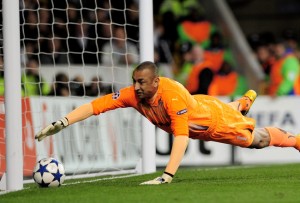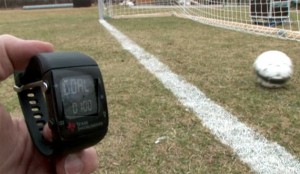Goal Line Technology Approved For Soccer, What’s Next?
Innovation in the world’s most popular sport
In a monumental decision that may affect professional sports the world over, IFAB, the International Football Association Board unanimously approved the use of goal-line technology for immediate implementation in soccer at the highest level. The technology will need to be licensed, installed and inspected in each individual stadium before it can be used, but should be seen on the pitch by 2013.
A spokesman for one of the top football leagues in the world, the English Premier League, reacted by saying that they intend on installing the new technology “as soon as practically possible.” IFAB wants to get the kinks ironed out and the technology approved for use in the 2014 World Cup.
HawkEye vs. GoalRef
There are two separate methods of goal line technology that may be coming to a field near you. One is available from a Sony owned company named HawkEye. HawkEye installs a number of different cameras which, through a process called triangulation, can determine the exact location of a ball and determine if it crossed the goal line or not. If you’ve been watching Wimbledon this week, then you’ve probably seen Hawkeye in action.
The rival method comes from a company called GoalRef. GoalRef actually installs a microchip within the ball, and a magnetic field interprets disturbances to determine whether or not a goal has occurred. The technology is so small and lightweight that it wouldn’t make a difference in performance.
Future Implications
Though there’s been an ongoing debate between purists and futurists about how to intertwine technology and sport, it’s tough to argue the necessity of the bond between the two. Within the last two years on the biggest stages in soccer, the World Cup and Euro 2012, goals were not granted that clearly should have been. Hawkeye and GoalRef technology will enable human referees to get the calls in the biggest moments right from the start.
Human error is definitely a part of all sports at all levels, but does it really need to be? When we have the capability to get a call right 100% of the time, why wouldn’t we jump on the opportunity?
Soccer obviously isn’t the first sport to take these types of measures, but could this unanimous ruling in the world’s most popular sport have a trickle down effect to other leagues in the world?
It’s obvious that a line needs to be drawn so as to not slow down a game entirely, but where would that line be? NFL Football has adapted their rules to automatically review all scoring plays, but should pass interference penalties be reviewable as well? NBA Basketball has stepped up to the plate by allowing reviews during the last two minutes of games, but should flops and charges be included too? Baseball has finally caught on to the trend and is reviewing home runs, but many calls are still missed down the first and third base lines. Should baseball use technology for fair and foul balls? How about to determine balls and strikes? This is where the debate gets dangerous.
Regardless of the potential arguments and pitfalls, billions of people worldwide play or watch sports everyday. In the big leagues or in the minors, it’s a devastating feeling to know that your team got robbed by a blown call. Fans spend untold amounts of dollars and hours on their favorite teams, so do the leagues owe it to us to fork over the estimated $200,000 installation fee to get as many calls right as possible?
It’s a fascinating debate, and a situation that will continue to evolve with time. With more and more instances of human error, we’re going to see more and more cries for change. Where do you stand on the issue?
Comments
Tags: goal line technology, goalref, hawkeye, instant replay, replay in sports, soccer review, technology and sports, technology in sports
Trackback from your site.



Comments (1)
Techin' In: Smart Basketball Syncs To Your Phone | 303 Magazine
| #
[...] a seamless blending of sports and technology in our daily lives. We’ve already seen the IFAB approve goal-line technology for determining goals in international soccer competitions and the Under Armour Smart Shirt [...]
Reply